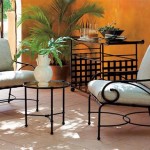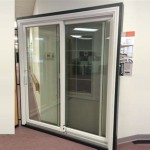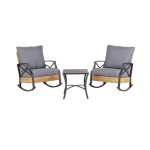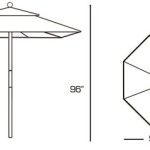Difference Between Patio and Deck Furniture
When designing an outdoor living space, selecting appropriate furniture is crucial for both aesthetics and functionality. The terms "patio furniture" and "deck furniture" are often used interchangeably, but understanding the nuances and differences between the two categories can help homeowners make informed purchasing decisions. While both are designed for outdoor use, subtle but significant distinctions in materials, construction, style, and intended environment exist, affecting their suitability for specific spaces and user preferences.
The terms "patio" and "deck" themselves describe different types of outdoor structures. A patio is typically a ground-level, paved outdoor area adjacent to a house. Common patio materials include concrete, brick, stone, or pavers. Decks, on the other hand, are raised platforms typically constructed from wood or composite materials. The elevated nature of a deck often provides views and distinct separation from the surrounding landscape.
These structural differences inform the requirements for suitable furniture. For example, the ground-level nature of a patio may expose furniture to different environmental conditions compared to a deck, influencing material choices. Similarly, the aesthetic of a wooden deck might complement furniture styles that contrast with the look of a concrete patio. Recognizing these differences is fundamental to selecting outdoor furniture that is both durable and aesthetically pleasing.
Material Composition and Durability
One of the primary distinctions between patio and deck furniture lies in the materials used in their construction. Both types of furniture need to withstand outdoor elements, but the specific materials chosen often reflect the perceived level of exposure and the overall design aesthetic. Durability, resistance to moisture, UV radiation, and temperature fluctuations are key considerations.
Patio furniture, often situated directly on the ground, tends to favor heavier, more robust materials. Common choices include cast aluminum, wrought iron, steel, and certain types of treated hardwoods like teak, shorea, or eucalyptus. These materials are chosen for their ability to endure direct exposure to rain, sun, and potential ground moisture. Cast aluminum is lightweight and rust-resistant, making it a popular option. Wrought iron provides substantial weight and stability, ideal for windy environments. Steel, especially if powder-coated, offers a balance of strength and affordability. Hardwoods, while requiring more maintenance, offer natural beauty and inherent resistance to decay and insects.
Deck furniture, being elevated, may sometimes be subjected to less intense ground-level moisture, allowing for a broader range of materials. While the durable materials used for patios are equally suitable for decks, lighter options like resin wicker, recycled plastic, and some treated softwoods might also be considered. Resin wicker, made from synthetic fibers, is lightweight, weather-resistant, and easy to clean. Recycled plastic is an environmentally friendly alternative that is highly durable and resistant to fading. Treated softwoods, although less durable than hardwoods, can be a cost-effective option when properly sealed and maintained.
The choice of fabric for cushions and upholstery also differentiates patio and deck furniture. Patio furniture often uses solution-dyed acrylic fabrics like Sunbrella, which are exceptionally resistant to fading, staining, and mildew. These fabrics are designed to withstand intense sun exposure and frequent rain. Deck furniture may also utilize solution-dyed acrylics, but depending on the level of protection offered by the deck's structure (e.g., a roof or overhang), other outdoor fabrics like polyester or olefin may suffice. These fabrics are generally less expensive than acrylic but offer adequate resistance to the elements for moderately protected spaces.
Ultimately, the material selection process should consider factors such as the expected environmental conditions, the desired lifespan of the furniture, and the homeowner's commitment to maintenance. Patio furniture, by virtue of its placement, often requires materials that can withstand more rigorous exposure. Deck furniture, while still needing to be durable, may offer more flexibility in material choices depending on the specific characteristics of the deck.
Style and Design Considerations
Beyond material durability, the style and design of patio and deck furniture are also important factors to consider. The architectural style of the house, the size and shape of the outdoor space, and the intended use of the area all influence the selection of furniture. The goal is to create a cohesive and inviting outdoor living space that reflects the homeowner’s personal taste.
Patio furniture often leans towards designs that complement the surrounding landscape. The materials and styles can sometimes be more rustic or grounded, integrating seamlessly with the earth tones of the patio surface and nearby garden elements. For example, wrought iron furniture with intricate scrollwork might be well-suited for a formal garden patio, while teak furniture with clean lines could complement a modern patio design featuring concrete pavers and minimalist landscaping.
Deck furniture, due to its elevated position, can often accommodate a wider range of styles. Because decks frequently offer views and serve as extensions of the home's interior living space, the furniture often mirrors interior design trends. Sleek, modern designs with clean lines and neutral colors are popular choices for contemporary decks. Comfortable seating arrangements with plush cushions and throw pillows, intended for relaxation and entertaining, are commonly found on decks.
The size of the furniture should be proportionate to the size of the outdoor space. Large, oversized furniture may overwhelm a small patio, while small, delicate pieces might get lost on a large deck. Consider the intended use of the space when selecting furniture. A dining table and chairs are essential for outdoor dining, while lounge chairs and sofas are ideal for relaxation and conversation. A bar area with stools can be a great addition to a deck designed for entertaining.
Color is another important design consideration. Neutral colors like beige, gray, and white are versatile and can easily be paired with other colors. Bright colors like red, blue, and yellow can add a pop of personality to the outdoor space. Consider the existing color palette of the house and surrounding landscape when choosing furniture colors. Coordinating the furniture with the overall design scheme will create a harmonious and visually appealing outdoor living space.
Accessories play a crucial role in completing the design of a patio or deck. Outdoor rugs can define seating areas and add warmth and texture to the space. Throw pillows and blankets can make the furniture more comfortable and inviting. Outdoor lighting can create ambiance and extend the usability of the space into the evening. Potted plants and flowers can add color and life to the outdoor area.
Maintenance Requirements and Longevity
The longevity and upkeep requirements of outdoor furniture are directly related to the materials used in its construction. Certain materials require more frequent maintenance than others, and understanding these differences is essential for preserving the furniture's appearance and structural integrity over the long term.
Patio furniture, often exposed to harsher conditions, typically requires more regular maintenance. Wrought iron and steel furniture should be inspected periodically for rust and repainted as needed. Teak and other hardwoods should be cleaned regularly and treated with oil or sealant to prevent drying and cracking. Concrete or stone patios can stain furniture, so protective feet or mats are vital. Cushions and fabrics should be cleaned regularly and stored indoors during inclement weather to prevent mildew and fading.
Deck furniture, while potentially benefiting from some degree of protection, still requires routine maintenance. Resin wicker furniture can be cleaned with soap and water. Recycled plastic furniture is virtually maintenance-free. Wood decks, and furniture that rests on wooden decks, are prone to rot and insect infestation, so regular inspection, cleaning, and sealing are necessary. Cushions and fabrics should still be protected from prolonged exposure to moisture and sunlight.
Proper storage during the off-season is crucial for maximizing the lifespan of outdoor furniture. Furniture covers can protect the furniture from snow, ice, and rain. Storing cushions and fabrics indoors during the winter months will prevent them from becoming damaged by the elements. Stacking or disassembling furniture can save space and make storage easier.
Investing in high-quality outdoor furniture is essential for ensuring its longevity. While cheaper options may seem appealing in the short term, they are often made from inferior materials that will not withstand the elements. High-quality furniture may cost more upfront, but it will ultimately save money in the long run by requiring less frequent replacement. Furthermore, considering the expected environmental conditions and choosing appropriate materials is paramount. Furniture placed in a coastal environment, for example, will require materials that are highly resistant to salt and corrosion.

The Differences Between Decks Balconies More Timbertech

What S The Difference Between A Lanai Patio Porch And Veranda

The Difference Between A Deck And Patio How To Decide Timbertech

How To Choose The Right Furniture For Your Composite Deck

15 Deck Furniture Ideas Design Inspiration Timbertech

Deck Vs Porch Decksdirect

Furniture For Composite Decking Scratch Resistant Options

9 Best Outdoor Deck Furniture Design Ideas Decks Com

9 Best Outdoor Deck Furniture Design Ideas Decks Com

13 Fun And Functional Outdoor Furniture Ideas Forbes Home
Related Posts








